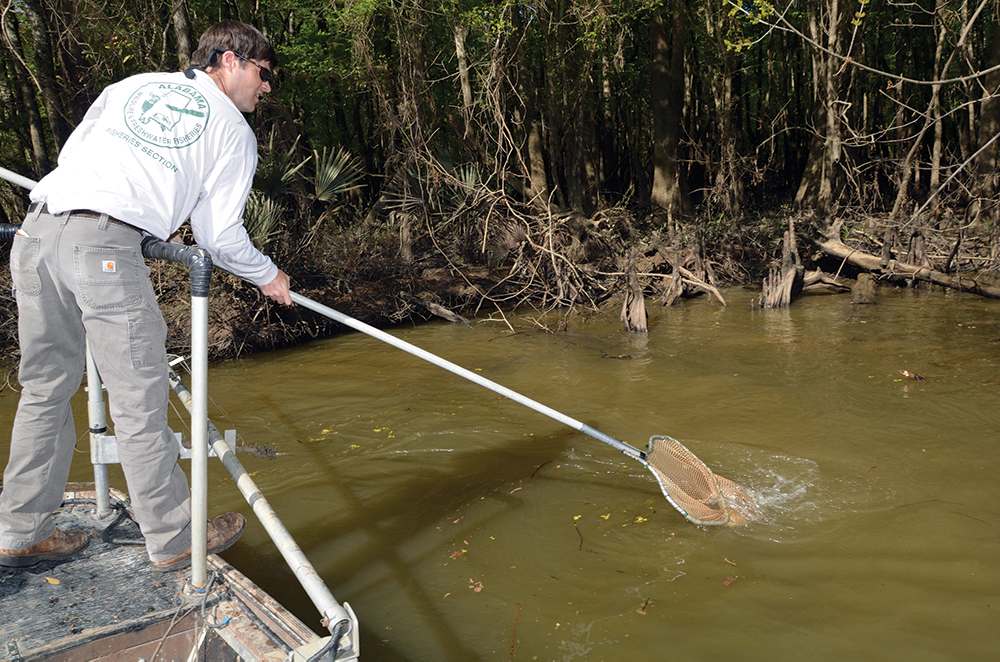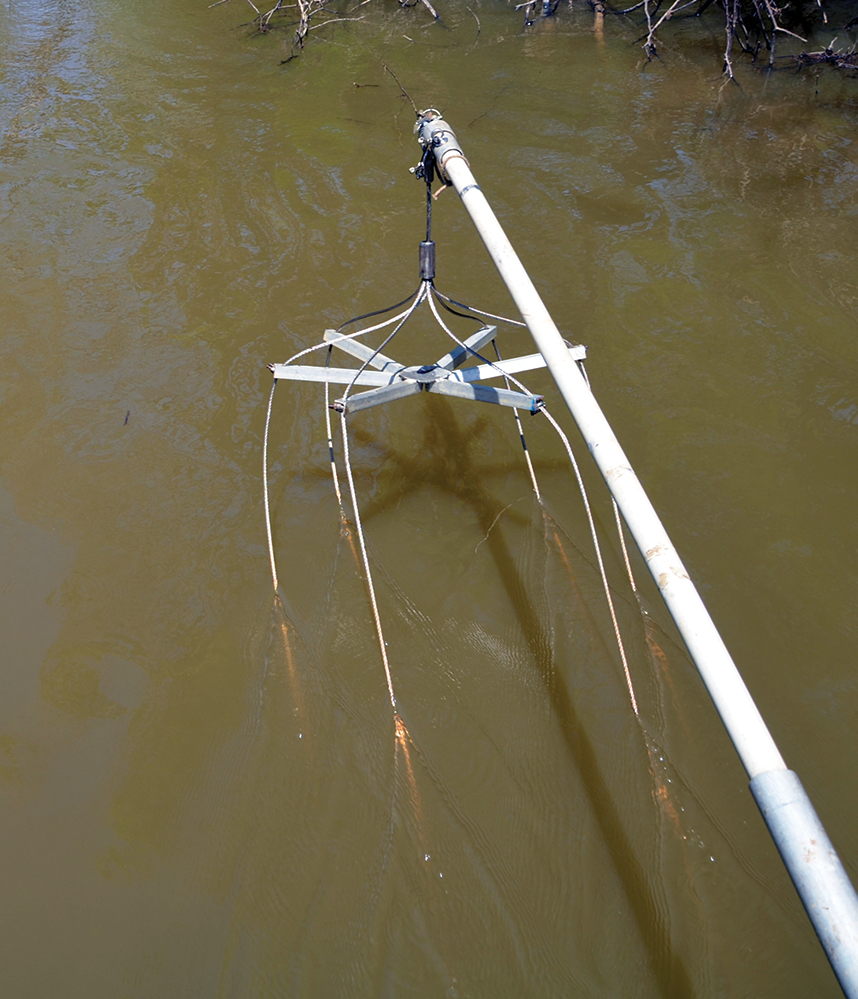Photos and column by John N. Felsher
As the boat pulled up next to a fallen tree along a wooded shoreline deep in the Mobile-Tensaw Delta, Dave and Tommy readied their fishing equipment. They unlimbered two long poles, but they weren’t tossing lures or dropping baits into the water. In fact, they weren’t using any kind of attractant at all. In reality, their equipment greatly repels fish, but they always return with a mess of assorted species.
From long poles dangling off boat bow, they dropped into the water what looked like extended bony fingers on two unclutched hands. Although the “hands” never grabbed a fish, moments after they entered the murky water, fish began jumping in all directions. Tommy worked furiously to net as many fish as possible and dump them into a livewell as fast as he could.
No ordinary fishermen using common recreational techniques this day, Dave Armstrong and Tommy Purcell work for the Alabama Wildlife & Freshwater Fisheries Division. They used a method called electrofishing or electrosampling. With electricity, biologists can quickly gather many fish of diverse species for sampling and scientific study.

They use the data collected to determine the health of a system so they can manage the waters to keep them productive.
“The Mobile-Tensaw Delta is one of about a half-dozen waterbodies in this district that we check periodically,” says Armstrong, the District V fisheries supervisor for the AWFFD in Spanish Fort. “We want to primarily monitor the sportfish populations like largemouth bass and crappie. Sometimes, we try to specifically target other different species.”
A generator on the boat creates electrical current. Beams, or poles, hold the metal probes, or droppers. Current flows into the droppers to shock fish. The boat serves as a “ground,” keeping the human occupants safe.
“The boat works like a cathode, or ground,” Armstrong says. “The beams and the droppers that come off the end is the anode. Between the boat hull and the droppers, we create an electrical charge. That electrical field surrounds the boat, but it’s concentrated off the bow where the droppers are. In the boat, we are safe, but if someone puts a finger in the water, it will get zapped.”
In the water, fish and other creatures feel the sting from the electrical charge and try to escape from it. The electric field varies in size, but generally goes as deep as six feet on average. In shallow water, fish can’t swim under it so they vault to the surface. Some try to jump clear of the water. Others float up to the surface temporarily stunned, making them easier to net.
“We try very hard not to kill fish,” Armstrong says. “Our goal is to get as many fish into the boat alive and release them as quickly as possible. The fish are stunned for a little while, but they revive very quickly. We can gather a lot of data on a lot of different fish species in a short amount of time. The delta probably has a greater diversity of species than any other part of the state.”

On this warm, sunny spring day, the team collected several species commonly landed by recreational anglers, including largemouth bass, crappie, catfish and assorted sunfish. The team recorded length and width measurements, weight and other data from species of interest before releasing most of the fish. However, they did keep some for further study back at the lab.
“We’ll keep a few fish for aging purposes,” Armstrong says. “We have to kill those fish, but that’s a small number. We take out their otoliths, or ear bones, which are like rings on a tree trunk. From those rings in its otolith, we can tell a lot about that fish’s growth in any given year. How much a fish grows depends on many variables, like temperature, rainfall, food availability, etc. We also get sex data on those fish.”

Besides the usual bass, bream and crappie, the team also caught chain pickerel, bowfin, shad, garfish and other species. The catch also included quillback carpsuckers, smallmouth buffalo and redhorse. I even saw some fish and other creatures that I’ve never seen before and didn’t know existed. Amazingly, prey and predators all live next to each other near fallen logs, old stumps, weed beds or other cover. When droppers enter the water, no telling what might pop up after the juice flicks on.
District V covers 11 counties in southern Alabama. Biological teams throughout the state conduct similar sampling in waters they manage.




